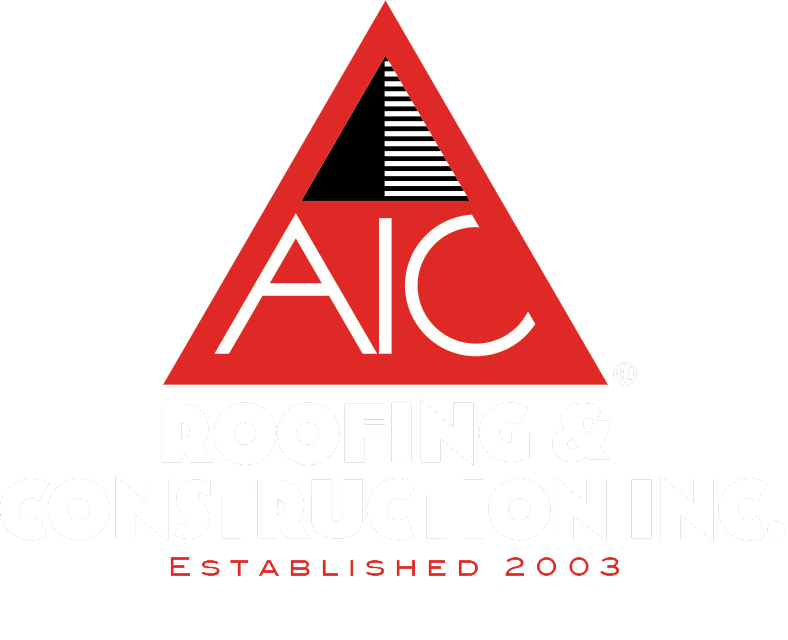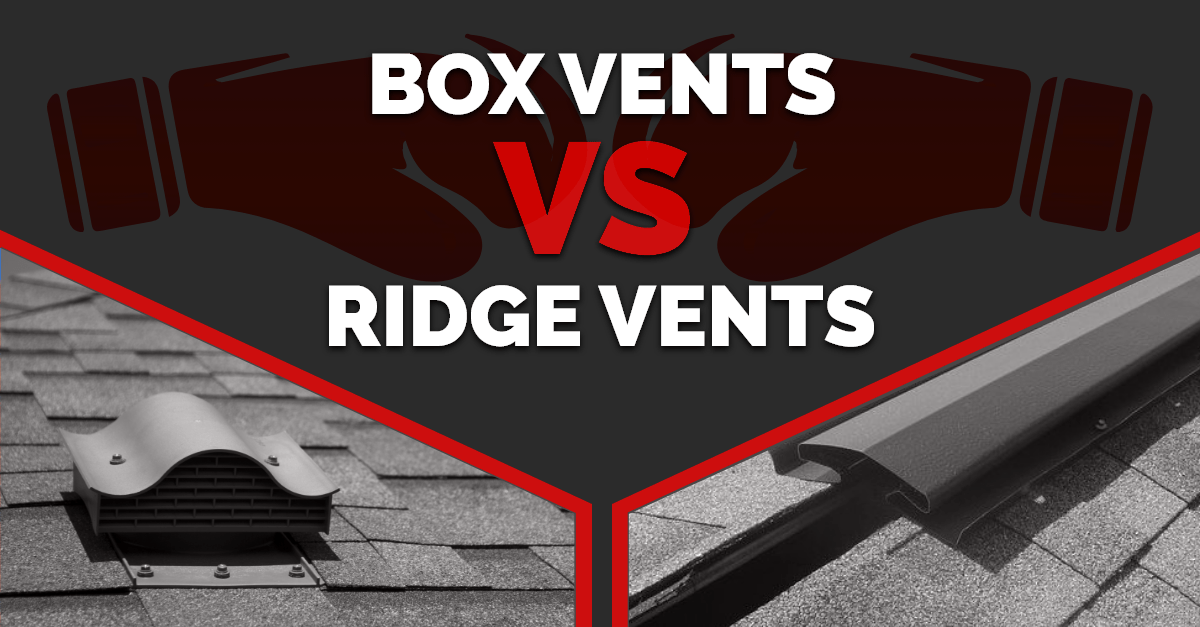When the time comes to replace your roof, you’ll have a lot of decisions to make. One of those decisions will be what type of ventilation you want with your new roofing system. Since most homeowners are not roofing experts, we commonly get asked, “What is the best ventilation system for a roof?” We want homeowners to feel knowledgeable and confident when making decisions about their roof replacement, which is why we created our Learning Center. This article will explain the difference between box and ridge vents, why ventilation is essential to your roof, and our recommendation.
Roof Ventilation Methods
Before explaining the difference between box vents and ridge vents, let’s first break down the types of ventilation methods. To properly ventilate your roof and attic space, cold air must be brought into your attic, and hot air must be expelled through vents. Because hot air rises, vents are typically placed near the peak of your roof for the most efficient process.
There are two types of ventilation systems – passive and active.
– Passive ventilation relies on natural forces – such as convection or wind, to operate. As cool air moves in, hotter air is pushed to the top and ultimately out of the vent.
– Active ventilation works by force. Active ventilation pulls in cooler outside air and pushes hot air out of your attic. Most forms of active ventilation will require a power source – whether solar or electric.
What is a Box Vent?
Box vents are a type of passive ventilation system. They are square-shaped vents that sit over a hole in your roof and are secured by nails and caulk to prevent leaks. Box vents have no mechanical parts and require no maintenance (aside from annual roof inspections to ensure they function properly). The exact number of box vents you’ll need will depend on your roof’s square footage.
The downside of traditional box vents is that they are more prone to leaking than ridge vents and offer small critters a way into your attic.
What is a Ridge Vent?
Ridge vents are a form of active ventilation. They are cut directly into a roof’s ridge line, which makes them extremely low profile. Ridge vents blend in with the rest of your roof and are much less noticeable than box vents from the ground. Their unobstructive nature makes them very popular among homeowners. Additionally, ridge vents are now manufactured out of durable plastic or aluminum, meaning they won’t rust over time.
Ridge vents are more expensive than box vents, but the cost may end up being very comparable. This is because ridge vents are so efficient that more box vents will have to be installed to achieve the same ventilation effect. A rule of thumb is that 40’ of ridge ventilation equals 18 box vents.
Box vs. Ridge Vents – Our Recommendation
Now that you know more about box vents and ridge vents, you’re probably wondering – “Which is best?” While both roof ventilation systems will get the job done, we recommend ridge vents to our homeowners. Remember, one ventilation system isn’t necessarily better than another, and each home is unique. However, ridge vents have superior functionality and a less intrusive appearance than box vents. Many homeowners also find their prices comparable, as many box vents are required to do the same amount of ventilation as one ridge vent.
If you have a complex roof with varying ridge heights and interconnected attic spaces, ridge vents would most likely be the most efficient option for your roof. Alternatively, ridge vents would not be an option if you have a flat or low-sloped roof.
Ventilation is critical to your roof
During the hot Louisville summers, rising hot air can easily reach temperatures of 170 degrees (or higher) in your attic. The ventilation system on your roof enables hot air to exit and prevents damage from these extreme temperatures, such as dry rot. Dry rot is a serious problem and can severely damage the most foundational elements of your roof – your roof decking.
Now that we’ve covered why ventilation is so important to your roof, here is a more comprehensive list of roof ventilation types you might consider in addition to box and ridge vents:
Types of active ventilation:
· Ridge vents
· Solar-powered vents
· Power Vents
Types of passive ventilation:
· Turbine vents
· Box vents (also known as turtle vents)
Choosing the ventilation system best for your home depends on your budget, home features, and desired appearance. While proper ventilation is crucial, hiring the right Louisville roofing company for your project is the most critical decision you’ll make during your roof replacement process.
We discuss what questions to ask a roofer before you hire them and even how to compare bids in more depth in our Learning Center.
What is my Roofing System Made of?
Your roof consists of much more than shingles and ventilation. All the elements listed below come together to form your roofing system. When it comes time for a roof replacement, your roofing contractor should replace each of these components to ensure your new roof functions properly and stands the test of time.
Your roofing system is comprised of the following:
· Decking: Your roof decking is the base layer of your roof. It is the OSB sheathing or plywood that shingles are fastened to.
· Underlayment: Underlayment is the material layer between your shingles and roof deck. This is the last line of defense against leaks.
· Ice & Water Shield: This is laid on top of your underlayment and forms a moisture-tight barrier around the nail holes in your shingles. It is extra leak protection placed in vulnerable, leak-prone areas.
· Drip Edge: A drip edge is a metal flashing positioned at the roof’s perimeter to direct water away from your fascia boards.
· Ventilation: As discussed, ventilation is important to keep your roof from overheating and sustaining damage. Proper ventilation is key to the longevity of your roof and decking.
· Pipe Boots: Pipe boots are the moisture-tight seal placed around plumbing vents.
· Shingles: Shingles are the most noticeable part of your roof and what most homeowners first think of when it comes to their roof.
· Flashing: Flashing directs water away from certain parts of your roof and into your gutters.
You may not have to replace your flashing during a roof replacement. However, replacing them during a roof replacement is cheaper and more efficient.
All these elements working together keeps your roof functioning properly. Ensuring each of these components is working as it should is what we do during a free, routine roof inspection. We recommend having your roof inspected annually to prevent leaks and extend the life of your roof for as long as possible.
Louisville Roof Repair and Replacement
Make sure your roof replacement is done right. Finding a trustworthy Louisville roofing contractor can be difficult. We walk you through best hiring practices and red flags to look out for with roofing contractors on our Learning Center and Youtube.
AIC Roofing and Construction has served the Louisville, Lexington, and Richmond communities since 2003. We are proud to be in the top 2% of roofing contractors to hold the GAF MasterElite certification and are an Owen’s Corning Platinum Preferred contractor. If you’re looking for a top-rated Louisville roofing company – we’d love to see if we would be a good fit for your project. Contact us today to schedule your free, no-hassle roof inspection.
3-tab attics barns chimney choosing a contractor commercial cost curb appeal DIY estimate financing flashing flat roof GAF glossary gutter replacement gutters gutter size gutter system ice dams inspections insurance missing shingles roof design roofing materials roofing system roof leak roof maintenance roof materials roof repair roof replacement roof shapes roof types shingle ratings shingles siding siding materials siding replacement skylights storm damage underlayment ventilation warranty winter







